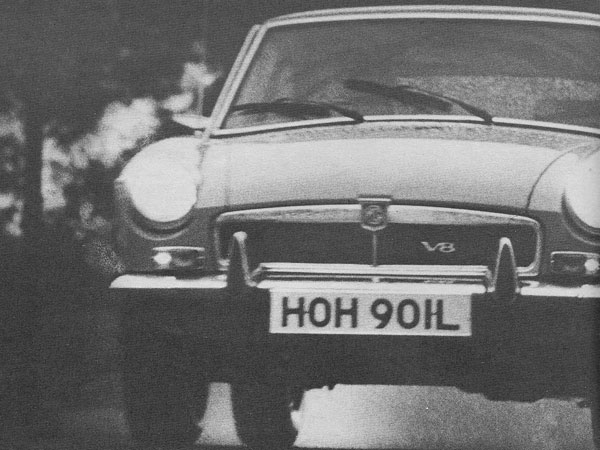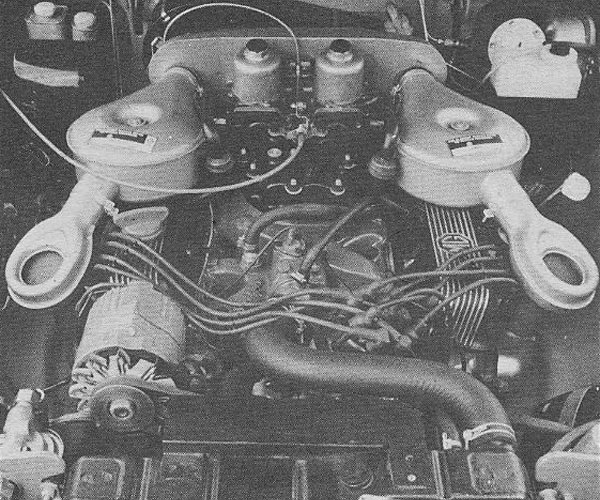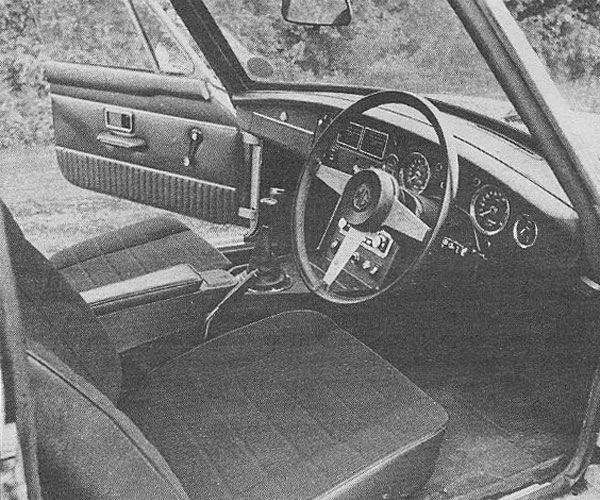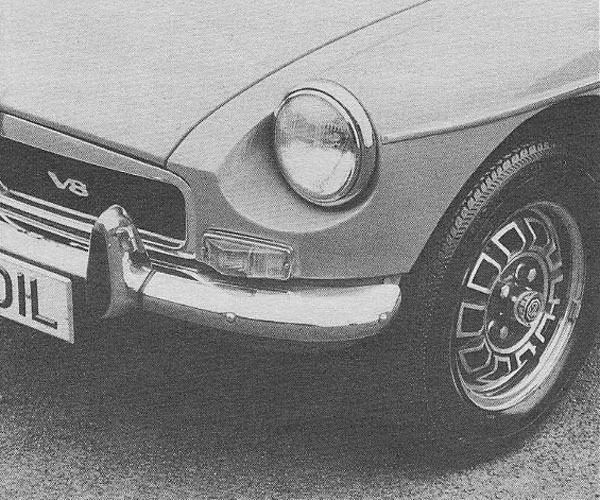�

�
MG V8: Too Little, Too Late, Too Much
�Better - only just, though - late than never
��
as published in BritishV8 Magazine, Volume XVI Issue 2, October 2008�
�
Re-printed unedited by exclusive permission of CAR magazine.
�
This article originally appeared in their issue for September 1973.�
�
by: Mel Nichols�
�
NOT LONG AGO, SOME succinct soul observed that by the time British Leyland �
realised buyers were neglecting the MGB because it was gutless and outdated, �
and not because interest was declining in the sports car market as a whole, �
it might be too late to save either the marque or the market. The nostalgia �
value of the MG name had better be strong enough to maintain its position as �
the Abingdon saviour, for the marque is not going to be greatly helped by the �
1973 offering of V8 power in the GT shell.�
�
All the V8 manages to do for the B is amplify its very long teeth. You get out �
of the car feeling only frustration for what might have-and should have-been. �
Perhaps we have all been naive by expecting too much, but it's still hard to �
believe that BLMC have done nothing to make it look like an MGB V8 other than �
tacking badges stolen from the Rover V8 onto the grille, flanks and tailgate, �
and bolting alloy-centred wheels onto the hubs. British Leyland have, of course, �
performed the transplant on the MGB at minimal cost and fuss. Perhaps as a �
reaction against the MGC, they decided not to put a power-hump in the bonnet �
to accommodate the V8 engine (from the C they certainly learnt not to call �
the car anything but a B). Instead, the engineers designed a new manifolding �
system that drops the twin SU carburettors to a low position at the rear of �
the heads. This gives a most unorthodox, almost Vintage, under-bonnet appearance; �
twin air filters sprouting lobster claws reach forward to pick up hot air from �
the exhaust manifolds (bimetallic valves in their tips switch over to cold air �
pickup in warm weather). Apart from an AC Delco alternator and free-flow exhaust �
systems, a bigger radiator cooled by twin electric fans and an oil cooler, the �
V8 is identical with the Rover TT5 unit. It develops 137bhp at 5000rpm with �
1931b/ft of torque at 2900rpm from its 3528cc; compression is 8.25 to one.�
�

�
(Note: in its original uncropped version, this photo filled about 1.5 magazine pages.)
�
� The gearbox mated to the V8 is a C-type unit, modified in detail: its casing � has been redesigned to take a larger clutch and the intermediate ratios have � been changed to more suitably match the torque curve of the V8. The electric � overdrive, which is standard, works only on top gear. The final drive ratio � has been dropped from the four-cylinder B's 3.91 to one, to a long-legged � 3.07 to one.�
��
Having nutted-out its bonnet- saving inlet manifolding, BLMC had only to �
change the bulkhead, very slightly modify the inner wheel arches to get �
clearance for the exhaust manifolds and alter the front cross-member to make �
room for the pile of ancillaries that go with the V8. It is the array of �
ancillaries that creates an interesting point about the MGB V8 - the engine �
itself weighs 40lb less than the ancient 1.8 litre four, but the extra �
equipment that must go with the V-form takes its total weight to a little �
more than the four. This upsets the B's front-to-rear weight balance slightly �
taking it from 47.8/52.2 to 49.4/50.6. Following the keep-it-cheap campaign �
(the entire project was wrapped up for a mere £200,000) only absolutely vital �
changes have been made to the way-back-when suspension.�
�
The rear leaf springs have been stiffened to cope with the very much greater �
torque, the front coils are heavier to carry the extra weight now over them �
and the dampers-lever arm all-around, remember? - haven't been touched. �
The new wheels are from Dunlop, five-inch rims by 14 inches tall, made �
pretty by having cast-alloy centres and cheap by having chromed steel rims �
riveted onto them. (BLMC are careful to point out that the wheels passed �
strength tests with flying colours). As footwear you get 175HR-14 radials; �
in the test car's case, Goodyear Grand Rallies. There are no changes to the �
disc/drum brakes.�
�
And there are no changes to the body, either. Not even to the grille, which �
stays just the same criss-cross mesh that they gave us in the facelift late �
last year. This issue of styling changes for the MGB V8 caused, we strongly �
suspect, more than a few ripples inside BLMC and MG. One of the MG styling �
men confessed to us that he and his colleagues had a bevy of nice little �
plans to really make the car look like 1973's MG. They would have at the same �
time, cured a few of the problems plaguing the B-GT, windnoise being the worst. �
Their plans were all knocked solidly on the head. Just drop in the engine, �
tack on the wheels and a couple of badges and be good boys, they were told.�
�
At the same time ideas of a drophead B GT were forgotten. Tests showed too �
much scuttle shake; the body just wasn't rigid enough without its steel roof. �
Customers might not always have been able to pick the deficiency, but the �
standards weren't high enough for them, say the engineers.�
�
Like the body, the interior is untouched, save for a smaller, leather-bound, �
steering wheel, and a speedo and a tachometer of 80mm diameter (in place of �
the more normal four-inch dials) for easier reading through the smaller wheel. �
You do get an outside mirror and tinted windows, but no radio as standard.�
�

�
�
Firing up the V8 brings that familiar smooth shrap' noise: strength and oomph, �
it says immediately you blip it, heaving the car slightly to the right with �
a healthy torque throw that seems strange in an MGB. The controls are light, �
which make the car pleasant to handle around the city. The clutch takes up �
positively as well as lightly, matching a quick, short-movement, gear change �
action.�
�
The car is deceptively quick - it will lope from 0 to 60mph in times of just �
over eight seconds and put down a standing quarter mile in 16.4 seconds if �
you kick it hard, but it doesn't feel very potent. It is smooth low down, �
certainly, although it does not give the impression of being really strong �
and torquey; brisk is the right word.�
�
Apart from second being too low, the gear ratios are well-suited to the V8. �
First to 39mph, second to 62, third to 97 and fourth to 122, Overdrive on �
the car we had was good for just a smidgin over 119mph - the 0.82 is just �
too high to allow the engine to pull out all its revs. This isn't purely a �
gearing problem. One of the car's most disappointing points is its lack of �
bite high up in the rev range. Once you get much past 4000rpm the engine �
feels quite weak, as if it's revving for the sake of revving and that's about �
all. Several times, when I wanted to overtake quickly I found I hadn't �
anything like the urge I wanted in top, dropped down to third and found that �
it wasn't much better. With this lack of urge high up there is little point �
running past 4500rpm, although the red line doesn't come until 5200rpm; the �
engine is still quite smooth up there in first and second - and third if you �
do care to persist with its use.�
�
What it boils down to is that this is a performance unit that is very good �
in many ways, but falls frustratingly short of being totally desirable. The �
good things are its ability to reach a high cruising speed quickly, and to �
hold it effortlessly: at 100mph in overdrive the tacho shows a moderate �
3500rpm. There is also fairly good fuel consumption which makes it possible �
to achieve 20mpg at a 100mph cruise.�
�
However, what shortcomings you may find with the engine shrink dramatically �
alongside other areas of this car:
�
• One is stability.
�
• Another is understeer.
�
• And another is windnoise. �
�
Because the engine is so quiet and the car tends to go faster more often, �
the serious aerodynamic deficiencies of the GT body become more apparent �
than before. At 85mph the windnoise is getting bad; at 100 it's loud; at 110 �
you may as well be standing in a hurricane - you're shouting; at 120 give up, �
you won't be heard anyway. The problem areas are the pillars and the sealing �
strips around the trailing edges of the front side windows. The door-mounted �
mirror contributes a lot of noise, too. Whatever happened to Frank Costin's �
aerodynamic outside mirror? The noise is in fact, abominable. It completely �
offsets the long, relaxed, touring ability of the engine and although I've �
been trying to think of a car that's worse for noise. I haven't succeeded.�
�
Enjoying this article? Our magazine is funded through the generous support of readers like you!
�
To contribute to our operating budget, please click here and follow the instructions.
�
(Suggested contribution is twenty bucks per year. Feel free to give more!)�
�
The stability problem lies both in the aerodynamics and the suspension. What �
happens is that at 100mph the car moves about as if it's being buffeted by a �
crosswind. It doesn't go a great distance across the road, but it's more than �
enough to annoy and worry a conscientious driver. It makes your wrists ache �
and you're battling at one end a distinctly unpleasant, nose-heavy, dead feeling, �
and at the other a tail that wants to stray around. The nose-heaviness is ever �
present, making the car feel much more like an MGC than it has any right to. �
It worries you most when you want to change direction - even so slightly as �
to correct those motorway wanderings - because the response to the steering �
input is slow.�
�
[BritishV8 editor's note: The MGB GT V8 model was exclusively sold in England, �
and in right-hand-drive configuration. "Car" magazine was almost exclusively sold �
in England. Therefore, it might be worthwhile to consider that England had and �
still has a national speed limit of 70mph. To drive 100mph - or even 85mph - in �
1973, a "conscientious driver" would be well-advised to take his car abroad �
because there were no roads in all of England built to German "Autobahn" or U.S. �
Federal Interstate Highway standards. For these reasons, we suggest that criticisms �
about 100+ mph windnoise and stability were pretty silly. The author reported �
(above) that the MGB GT V8 had a 49.4% / 50.6% front-to-rear weight distribution. �
Keep that in mind as he continues to call the car "nose heavy". By the end of the �
article, you'll see that he preferred front-wheel-drive, four-cylinder cars like �
the Lancia HF 1600 which incidentally provided quite a lot less power and �
demanded a significant price premium compared to the MGB GT V8. Front-wheel-drive �
forsooth!]�
�
So, beset with this nose-heaviness the B V8 never feels a happy car. On bendy �
roads it is loathe to come cleanly and quickly onto the line you want; and the �
very quick 16.4 to one rack-and-pinion steering loads up as you lift it into �
the corner, so your wrists ache some more. In anger more than anything else �
you can reach for second and thump on the power to go around in oversteer - �
messy, and not even fun in this instance. �
�
Although the revised springing doesn't cope too well with the new weight �
distribution, it does look after the ride satisfactorily. It's firm, although �
not in the slightest bit uncomfortably, and there is very little body roll. �
Yet despite this quite respectable ride, the car really does feel old on the �
road. Add to that, the interior hits you with the same feeling: the confined, �
low-vision cabin with thick pillars; the dashboard that's near-as-dammit to �
the way it appeared in the first B roadster 10 years ago. I suppose it's �
functional and unobtrusive, but it's not up to the image of the car or £2300 �
1973 standards. The same applies to the instruments, which all reflect far �
too much.�
�

�
�
Where the car is pleasant is in the seats and in the layout of the driving �
position. The seats hold their occupants both comfortably and capably, and �
the driver sits with his arms at a pleasant distance from the wheel and �
gearlever. The tiny, fold-down, rear seat is really only capable of toting �
kids; better to drop it and use the space for luggage-something that the GT �
is well able to move in quantity after it's loaded via the swing-up rear door.�
�
In their press release material on the B V8, British-Leyland claim that "...it �
offers a winning combination of classic, sports car styling, outstanding performance �
and handling, appealing interior and equipment. None of the sporty coupes can match �
it." That's a pretty broad claim, so let's see how the new MG compares with those �
who can be said to be rivals:�
�
Starting at the bottom, there's the Capri 3000GXL. With the works, sun-roof �
and all, it costs around £1900. With a 123mph top speed, the Capri just has an edge �
on the MG. It matches the V8 for acceleration too, and has at least as much �
sporting feel. The V6 is just as torquey on the road and is quite definitely �
more spritely than the 3.5, although to maintain cruising speeds matching those �
of the B the fuel consumption is worse because the V6 uses more revs per mile.�
�
As we pointed out in our Giant Test (August issue) the Capri is a sloppy handler, �
affected badly by bumpsteer and understeer. In the MG, too, you have to thump on �
the power to bring on oversteer. So both cars are about equal in their handling, �
although the Capri suffers from none of the B's high-speed instability and, lacking �
serious windnoise, is a better touring car. One of the advantages the B V8 offers �
over many of its opponents is that it is built by a major manufacturer, has a �
well-known engine and is easily serviced. But the Capri is built by an even bigger �
manufacturer and has an even more common engine. It is just as comfortable as the �
B, can seat two extra citizens with fewer problems, has a more appealing interior �
and a better equipment level... and a lower price. Despite the poor handling, there's �
no question which car is the better value for money. �
�
At £1931 there is the Jensen-Healey. In theory, if not in practice, you can �
have it with a hard-top, so it can be fairly considered an opponent for the MGB V8. �
It doesn't have the lugging power of the V8, but it does have a smooth, fuss-free, �
sporting engine that thrives on revs and puts up performance so close to the MG's �
that the difference doesn't really matter. It handles better, rides better, has a �
better interior and is more comfortable. �
�
For £2397 you can drive away in a Lancia Fulvia HF 1600 which is a honey of �
a coupe. It is not in the B's performance league, but find it a bendy road and its �
front-wheel-drive agility will leave the MG gasping. Has a five-speed box. �
�
Just two more pounds will buy a BMW 2002. Once again, way down in power and �
performance, but quiet, smooth and stable, and a fair enough handler, but lacking �
the easy cruising ability of the 3.5litre V8.�
�
For pure performance the TVR 3000M rears its stubby head at £2464, shading �
the B for acceleration, leaving it in the bends too, and is just as comfortable for �
two, but bear in mind the decided disadvantage of coming from a rather obscure family.�
�

�
�
Although the Reliant Scimitar GTE, comes from a smallish factory it is held �
in very high regard and does not cost much more than the MG. It is a better car �
than the MGB GT, and one of similar ilk. The Stag and the Opel Commodore GS are �
similarly close in price, too. (See the Giant Test in this issue.)�
�
Then at £2535 there is the Datsun 240Z. One of the best-looking coupes �
around, and known for its beautifully smooth and strong six-cylinder engine that �
can outrun the B by three mph and hold it firmly all the way in acceleration. It �
has a five-speed gearbox for both performance and relaxed touring, some steering �
vagueness and a little front-end float, but otherwise handling that allows the �
driver to enjoy himself, and a cockpit that is modern and impressive. Even though �
it costs £200 more, it is better value than the B.�
�
If you can bear to come down to half the number of cylinders, the Lotus Plus 2S �
is remarkable for having a top speed of just on 120mph, plus a 0-60mph time of 8.1 �
seconds. It's not a cheap car anymore, not at £2789, but the cost is easily justified �
by the sheer agility and finesse built into its dynamic qualities. Although performance �
is similar to the B V8's. it achieves it with revs more than torque, so some of what �
you pay for is the sophisticated suspension.�
�
Both up and down the price scale, the MGB GT V8 comes off quite badly. It's not a bad �
car: it's just not a very good one, and is a long way from being the answer to an MG �
fan's prayers. The most fitting comment lays in the adage: Better late than never.�
�
� BritishV8 Magazine has assembled the largest, most authoritative collection of MG � "MGB GT V8" information you'll find anywhere. Check it out! � Access our � MGB GT V8 article index by clicking here. �
�
